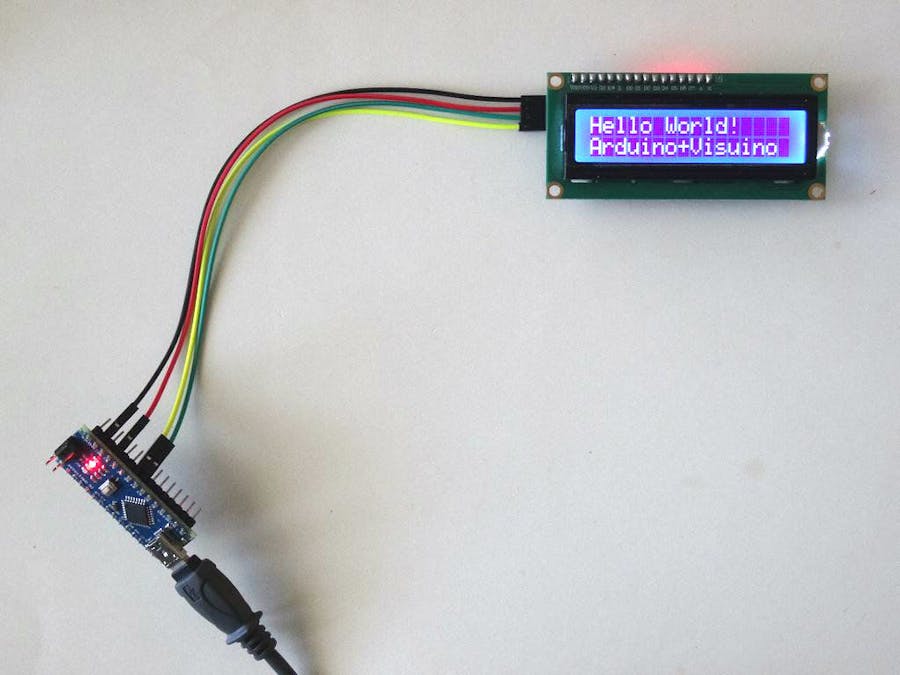Character LCD Displays are a very commonly used for Arduino projects, to display small amounts of textual information. The most common types are the basic directly connected displays, and the ones with I2C adapter. The I2C version is more expensive but needs only 4 wires to connect to Arduino, which makes it very attractive and an easy-to-use option for Arduino projects.
I already made a Tutorial on how to directly connect an LCD display to Arduino. In this Tutorial, I will show you how easy it is to connect such I2C LCD Display to Arduino Nano, and program it with Visuino to display whatever is typed in a Serial Terminal.
Step 1: Components- One Arduino compatible board (I use Arduino Nano, because I have one, but any other will be just fine)
- One I2C 16x2 LCD Display (Back side of the LCD with the I2C adapter showed on Picture 2)
- 4 Female-Female jumper wires
- Connect Ground (black wire), Power (red wire), SDA (green wire), and SCL (yellow wire) to the LCD Module (Picture 1)
- Connect the other end of the Power wire (red) to the 5V power pin of the Arduino board (Picture 2)
- Connect the other end of the Ground wire (black) to Ground pin of the Arduino board (Picture 2)
- Connect the SDA wire (green) to SDA/Analog pin 4 of the Arduino Nano board (Picture 2)
- Connect the SCL wire (yellow) to SCL/Analog pin 5 of the Arduino Nano board (Picture 2)
- Picture 3 shows where are the Ground, 5V Power, SDA/Analog pin 4, and SCL/Analog pin 5 pins of the Arduino Nano
To start programming the Arduino, you will need to have the Arduino IDE installed from here: http://www.arduino.cc/ .
Please be aware that there are some critical bugs in Arduino IDE 1.6.6.
Make sure that you install 1.6.7 or higher, otherwise this Tutorial will not work!
The Visuino: https://www.visuino.com also needs to be installed.
- Start Visuino as shown in the first picture
- Click on the "Tools" button on the Arduino component (Picture 1) in Visuino
- When the dialog appears, select Arduino Nano as shown in Picture 2
- Type "lcd" in the Filter box of the Component Toolbox then select the "Liquid Crystal Display (LCD) - I2C" component (Picture 1), and drop it in the design area
- Connect the "Out" pin of the LCD component to the to the "In" pin of the I2C channel of the Arduino component (Picture 2)
- Connect the "Out" pin of the "Serial[ 0 ]" channel of the Arduino component (Picture 3) to the "In" pin of the LCD component (Picture 4)
- In Visuino, Press F9 or click on the button shown on Picture 1 to generate the Arduino code, and open the Arduino IDE
- In the Arduino IDE, click on the Upload button, to compile and upload the code (Picture 2)
Congratulations! You have completed the project.
Picture 1 shows the connected and powered up project.
If you open Serial Terminal in the Arduino IDE or Visuino, type some text and press Enter, you should see the text appearing on the LCD.
Avoid entering lines of text of more characters than the LCD has per line, as you can overflow its buffers.
On Picture 3 you can see the complete Visuino diagram.
Also attached is the Visuino project, that I created for this Tutorial. You can download and open it in Visuino: https://www.visuino.com









Comments
Please log in or sign up to comment.